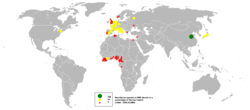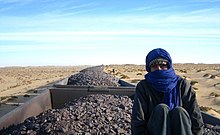
Back اقتصاد موريتانيا Arabic Economia de Mauritània Catalan Wirtschaft Mauretaniens German Economía de Mauritania Spanish Économie de la Mauritanie French Economía de Mauritania Galician Մավրիտանիայի տնտեսությունը Armenian Ekonomio di Mauritania IO モーリタニアの経済 Japanese 모리타니의 경제 Korean
 | |
| Currency | Ouguiya (MRU, UM) |
|---|---|
| Calendar Year | |
Trade organisations | AU, AfCFTA, AfDB, CEN-SAD, WTO, Group of 77 |
| Statistics | |
| GDP | |
GDP growth |
|
GDP per capita | |
GDP by sector | agriculture (14.9%) industry (48.0%) services (37.1%) (2012 est.) |
| 3.053% (2018 est.)[1] | |
Population below poverty line | 40% (2004 est.) |
| 39 (2000) | |
Labour force | 1.318 million (2007) |
Labour force by occupation | agriculture (50.0%) industry (2%) services (48%) (2001 est.) |
| Unemployment | 30% (2008 est.) |
Main industries | mining (iron ore, gold, copper, gypsum), petroleum, fish processing |
| External | |
| Exports | |
Export goods | iron ore, petroleum, gold, copper, gypsum, fish |
Main export partners | |
| Imports | |
Import goods | machinery, petroleum products, food |
Main import partners | |
Gross external debt | |
| Public finances | |
| Revenues | $1.143 billion (2012 est.) |
| Expenses | $1.263 billion (2012 est.) |

The economy of Mauritania is still largely based on agriculture and livestock, even though most of the nomads and many subsistence farmers were forced into the cities by recurring droughts in the 1970s and 1980s.

Mauritania has extensive deposits of iron ore, which account for almost 50% of total exports. The decline in world demand for this ore, however, has led to cutbacks in production. With the current rise in metal prices, gold and copper mining companies are opening mines in the interior.
The nation's coastal waters are among the richest fishing areas in the world, but overexploitation by foreigners threatens this key source of revenue. The country's first deep water port opened near Nouakchott in 1986.
In recent years, drought and economic mismanagement have resulted in a buildup of foreign debt. In March 1999, the government signed an agreement with a joint World Bank-International Monetary Fund mission on a $54 million enhanced structural adjustment facility (ESAF). The economic objectives have been set for 1999–2002. Privatization remains one of the key issues.
- ^ a b c d e "World Economic Outlook Database, April 2023". IMF.org. International Monetary Fund. Retrieved 23 April 2023.
- ^ "Global Economic Prospects, June 2019: Heightened Tensions, Subdued Investment. p. 127" (PDF). openknowledge.worldbank.org. World Bank. Retrieved 15 November 2019.
- ^ "Human Development Index (HDI)". hdr.undp.org. HDRO (Human Development Report Office) United Nations Development Programme. Retrieved 9 September 2022.
- ^ "Inequality-adjusted Human Development Index (IHDI)". hdr.undp.org. HDRO (Human Development Report Office) United Nations Development Programme. Retrieved 11 December 2019.
- ^ "Mauritania trade balance, exports and imports by country 2022". OEC. 2021. Retrieved 2021-10-25.
- ^ "Mauritania trade balance, exports and imports by country 2021". OEC. 2021. Retrieved 2022-10-25.}
© MMXXIII Rich X Search. We shall prevail. All rights reserved. Rich X Search